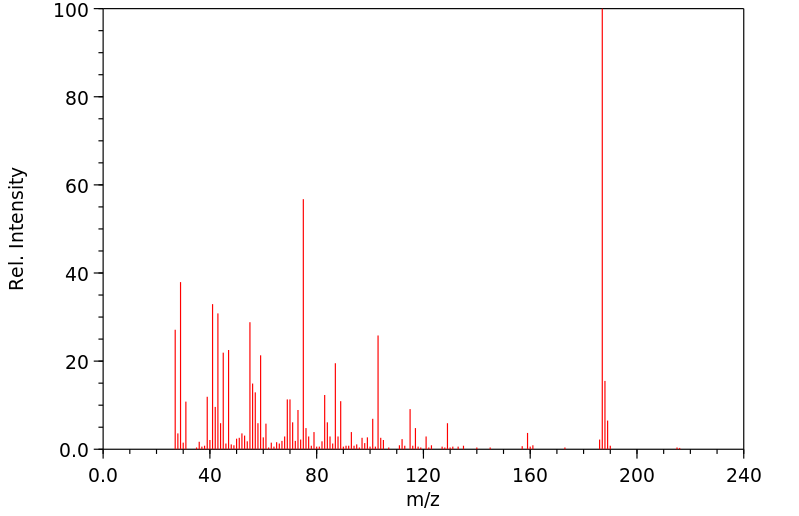三乙基(己氧基)硅烷 | 18107-40-9
中文名称
三乙基(己氧基)硅烷
中文别名
——
英文名称
Triaethyl-hexyloxy-silan
英文别名
Triethyl-n-hexoxy-silan;triethyl-hexyloxy-silane;1-Triethylsilyloxyhexane;triethyl(hexoxy)silane
CAS
18107-40-9
化学式
C12H28OSi
mdl
——
分子量
216.439
InChiKey
ATOZVXNLUNOTMX-UHFFFAOYSA-N
BEILSTEIN
——
EINECS
——
-
物化性质
-
计算性质
-
ADMET
-
安全信息
-
SDS
-
制备方法与用途
-
上下游信息
-
文献信息
-
表征谱图
-
同类化合物
-
相关功能分类
-
相关结构分类
物化性质
-
沸点:225-225.5 °C
-
密度:0.8223 g/cm3
-
保留指数:1262
计算性质
-
辛醇/水分配系数(LogP):4.59
-
重原子数:14
-
可旋转键数:9
-
环数:0.0
-
sp3杂化的碳原子比例:1.0
-
拓扑面积:9.2
-
氢给体数:0
-
氢受体数:1
反应信息
-
作为反应物:描述:参考文献:名称:Copper(II) bromide as efficient catalyst for silyl- to bisarylmethyl ethers interconversion (transprotection)摘要:Primary and secondary silylated alcohols are easily converted to bis(methoxyphenyl)methyl (BMPM) ethers in good yields using CuBr2 as catalyst in acetonitrile at room temperature. Various other protecting groups are compatible with this mild and convenient process. (C) 2011 Elsevier Ltd. All rights reserved.DOI:10.1016/j.tetlet.2011.08.148
-
作为产物:描述:Triethyl(hex-5-ynoxy)silane 在 氢气 作用下, 以 甲醇 为溶剂, 20.0 ℃ 、101.33 kPa 条件下, 反应 12.0h, 以92%的产率得到三乙基(己氧基)硅烷参考文献:名称:使用固定在陶瓷上的钯催化剂进行独特的化学选择性加氢摘要:开发了负载在陶瓷上的非均相钯催化剂(5%Pd /陶瓷)。该催化剂对氢化显示出特定的化学选择性,这是其他钯催化方法无法实现的。脂族或芳族N- Cbz基团都可以脱保护为相应的游离胺,而苄基酯和醚的氢解反应却没有进行。此外,芳族氯化物和环氧化物在钯/陶瓷催化的氢化条件下具有耐受性。由于在反应介质中未检测到钯浸出,因此可以重复使用5%的Pd /陶瓷,而不会降低催化剂活性。DOI:10.1002/cctc.201500193
文献信息
-
Action des trialkylsilanes sur les aldehydes aliphatiques作者:Rolland Bourhis、Emile FrainnetDOI:10.1016/s0022-328x(00)89613-8日期:1975.2Two competing reactions ensue when trialkylsilanes HSiR′3 are treated with aliphatic aldehydes RCHO in the absence of a solvent and using a nickel catalyst (obtained by the treatment of anhydrous NiCl2 with a trialkylsilane); one gives an alcoxysilane RCH2OSiR′3, the other an ether oxide (RCH2)2O and a siloxane (R′3Si)2O. By variation of the reaction conditions, either reaction can be made exclusive
-
Hydrosilylation of epoxides catalyzed by a cationic η1-silane iridium(iii) complex作者:Sehoon Park、Maurice BrookhartDOI:10.1039/c0cc05714b日期:——Cationic silane complex 2, catalyzes the hydrosilylation of epoxides and cyclic ethers to give the silyl-protected alcohols, regioselectively. A mechanistic study shows that the epoxide undergoes isomerization to the ketone, followed by hydrosilylation.
-
Hydrosilylation of carbonyls over electron-enriched Ni sites of intermetallic compound Ni<sub>3</sub>Ga heterogeneous catalyst作者:Tomoaki Takayama、Rio Kariya、Yuki Nakaya、Shinya Furukawa、Seiji Yamazoe、Takayuki KomatsuDOI:10.1039/d0cc07916b日期:——
Nanoparticulate intermetallic compound Ni3Ga supported on SiO2 has emerged as a highly efficient catalyst for the hydrosilylation of carbonyls, such as aldehydes and ketones, at room temperature.
-
Action du triethylsilane sur des aldehydes α-ethyl-eniques en presence de catalyseurs au nickel ou au palladium作者:Rolland Bourhis、Emile Frainnet、Françoise MoulinesDOI:10.1016/s0022-328x(00)92269-1日期:1977.11The action of triethylsilane on α-ethylenic aldehydes has been studied in the presence of two types of nickel catalysts as well as palladium on charcoal. Two phenomena can result: either 1,2 or 1,4 additions only, the trans-1,4 adduct being predominant, or a competition between these two additions and coupling reactions. A comparative regioselective and stereoselective study was carried out making
-
Dolgow et al., Zhurnal Obshchei Khimii, 1954, vol. 24, p. 1178,1182, 1185; engl.Ausg.S. 1169, 1172, 1173作者:Dolgow et al.DOI:——日期:——
表征谱图
-
氢谱1HNMR
-
质谱MS
-
碳谱13CNMR
-
红外IR
-
拉曼Raman
-
峰位数据
-
峰位匹配
-
表征信息
同类化合物
(2-溴乙氧基)-特丁基二甲基硅烷
鲸蜡基聚二甲基硅氧烷
骨化醇杂质DCP
马沙骨化醇中间体
马来酸双(三甲硅烷)酯
顺式-二氯二(二甲基硒醚)铂(II)
顺-N-(1-(2-乙氧基乙基)-3-甲基-4-哌啶基)-N-苯基苯酰胺
降钙素杂质13
降冰片烯基乙基三甲氧基硅烷
降冰片烯基乙基-POSS
间-氨基苯基三甲氧基硅烷
镓,二(1,1-二甲基乙基)甲基-
镁,氯[[二甲基(1-甲基乙氧基)甲硅烷基]甲基]-
锑,二溴三丁基-
铷,[三(三甲基甲硅烷基)甲基]-
铂(0)-1,3-二乙烯-1,1,3,3-四甲基二硅氧烷
钾(4-{[二甲基(2-甲基-2-丙基)硅烷基]氧基}-1-丁炔-1-基)(三氟)硼酸酯(1-)
金刚烷基乙基三氯硅烷
酰氧基丙基双封头
达格列净杂质
辛醛,8-[[(1,1-二甲基乙基)二甲基甲硅烷基]氧代]-
辛甲基-1,4-二氧杂-2,3,5,6-四硅杂环己烷
辛基铵甲烷砷酸盐
辛基衍生化硅胶(C8)ZORBAX?LP100/40C8
辛基硅三醇
辛基甲基二乙氧基硅烷
辛基三甲氧基硅烷
辛基三氯硅烷
辛基(三苯基)硅烷
辛乙基三硅氧烷
路易氏剂-3
路易氏剂-2
路易士剂
试剂Cyanomethyl[3-(trimethoxysilyl)propyl]trithiocarbonate
试剂3-[Tris(trimethylsiloxy)silyl]propylvinylcarbamate
试剂3-(Trimethoxysilyl)propylvinylcarbamate
试剂2-(Trimethylsilyl)cyclopent-2-en-1-one
试剂11-Azidoundecyltriethoxysilane
西甲硅油杂质14
衣康酸二(三甲基硅基)酯
苯胺,4-[2-(三乙氧基甲硅烷基)乙基]-
苯磺酸,羟基-,盐,单钠聚合甲醛,1,3,5-三嗪-2,4,6-三胺和脲
苯甲醇,a-[(三苯代甲硅烷基)甲基]-
苯并磷杂硅杂英,5,10-二氢-10,10-二甲基-5-苯基-
苯基二甲基氯硅烷
苯基二甲基乙氧基硅
苯基二甲基(2'-甲氧基乙氧基)硅烷
苯基乙酰氧基三甲基硅烷
苯基三辛基硅烷
苯基三甲氧基硅烷







